Journal Description
Photonics
Photonics
is an international, scientific, peer-reviewed, open access journal on the science and technology of optics and photonics, published monthly online by MDPI.
- Open Access— free for readers, with article processing charges (APC) paid by authors or their institutions.
- High Visibility: indexed within Scopus, SCIE (Web of Science), Inspec, Ei Compendex, CAPlus / SciFinder, and other databases.
- Journal Rank: JCR - Q2 (Optics)
- Rapid Publication: manuscripts are peer-reviewed and a first decision is provided to authors approximately 14.9 days after submission; acceptance to publication is undertaken in 1.9 days (median values for papers published in this journal in the second half of 2024).
- Recognition of Reviewers: reviewers who provide timely, thorough peer-review reports receive vouchers entitling them to a discount on the APC of their next publication in any MDPI journal, in appreciation of the work done.
- Companion journal: Lights.
Impact Factor:
2.1 (2023);
5-Year Impact Factor:
2.1 (2023)
Latest Articles
High-Q Resonances Enabled by Bound States in the Continuum for a Dual-Parameter Optical Sensing
Photonics 2025, 12(6), 554; https://doi.org/10.3390/photonics12060554 (registering DOI) - 30 May 2025
Abstract
Optical sensing technologies, particularly refractive index and temperature sensing, are pivotal in biomedical, environmental, and industrial applications. This study introduces a dual-parameter all-dielectric transmissive grating sensor leveraging symmetry-protected bound states in the continuum (BICs). A one-dimensional silicon grating on a silica substrate was
[...] Read more.
Optical sensing technologies, particularly refractive index and temperature sensing, are pivotal in biomedical, environmental, and industrial applications. This study introduces a dual-parameter all-dielectric transmissive grating sensor leveraging symmetry-protected bound states in the continuum (BICs). A one-dimensional silicon grating on a silica substrate was designed and analyzed using finite element analysis software. The proposed grating structure enables the excitation of two distinct BICs, both exhibiting high quality factors (Q-factors) of
(This article belongs to the Special Issue Bound States in the Continuum in Photonics, Plasmonics, and Terahertz Technology)
►
Show Figures
Open AccessArticle
Raman Hyperspectroscopy and Chemometric Analysis of Blood Serum for Diagnosing Celiac Disease in Adults
by
Entesar Al-Hetlani, Lamyaa M. Almehmadi and Igor K. Lednev
Photonics 2025, 12(6), 553; https://doi.org/10.3390/photonics12060553 - 30 May 2025
Abstract
Celiac disease (CD) is a chronic autoimmune disorder triggered by an abnormal immune response to gluten, a protein found in wheat, barley, and rye. Current diagnostic methods, including serological assessments and biopsies, can be challenging due to the disease’s heterogeneous nature, creating a
[...] Read more.
Celiac disease (CD) is a chronic autoimmune disorder triggered by an abnormal immune response to gluten, a protein found in wheat, barley, and rye. Current diagnostic methods, including serological assessments and biopsies, can be challenging due to the disease’s heterogeneous nature, creating a need for a reliable, noninvasive diagnostic approach. Here, in this study, we aimed to extend the Raman peak area ratios approach to the adult population. However, our findings indicate no significant differences in Raman peak area ratios between healthy and diseased adults based on blood serum samples. Nevertheless, genetic algorithm combined with partial least squares discriminant analysis (GA-PLS-DA) allowed differentiation with 92% sensitivity and 96% specificity at the spectral level in external validation. Receiver operating characteristic (ROC) analysis showed 100% classification at the donor level in external validation. These results demonstrate further that Raman spectroscopy, combined with chemometrics, is a promising, noninvasive tool for CD diagnosis.
Full article
(This article belongs to the Special Issue Biomedical Photonics)
►▼
Show Figures
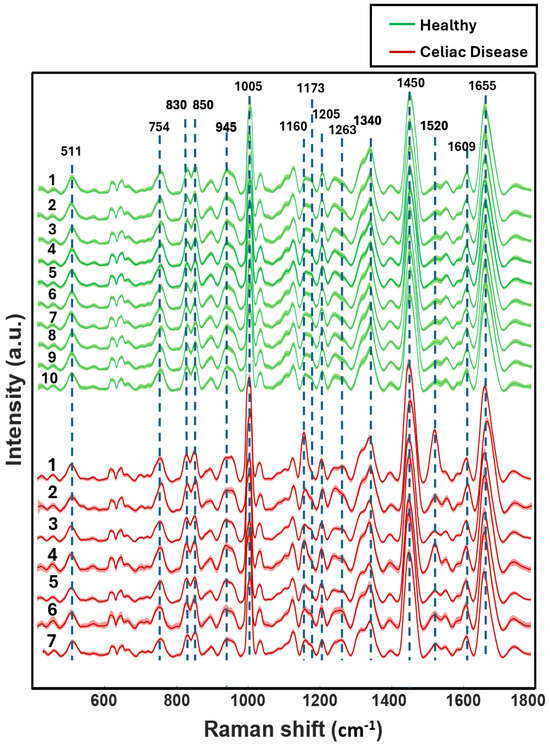
Figure 1
Open AccessArticle
High-Efficiency Polarization-Independent LCoS Utilizing a Silicon-Based Metasurface
by
Yuxi Deng, Boyun Liu and Jinhua Yan
Photonics 2025, 12(6), 552; https://doi.org/10.3390/photonics12060552 - 30 May 2025
Abstract
In this paper, we propose and demonstrate a liquid crystal on silicon (LCoS) device that achieves high-efficiency, broadband, polarization-independent phase modulation by integrating a metasurface between the liquid crystal layer and the backplane of a commercial LCoS device. The metasurface is composed of
[...] Read more.
In this paper, we propose and demonstrate a liquid crystal on silicon (LCoS) device that achieves high-efficiency, broadband, polarization-independent phase modulation by integrating a metasurface between the liquid crystal layer and the backplane of a commercial LCoS device. The metasurface is composed of rectangular silicon pillars encapsulated in silicon dioxide. By precisely adjusting the orientation and dimensions of these silicon pillars, the metasurface effectively controls the polarization state of the incident light, enabling polarization-independent phase modulation across the C+L band. Experimental results show that the polarization conversion ratio remains approximately 95% throughout the entire C+L band under varying driving voltages. Due to the low absorption characteristics of silicon and silicon dioxide, the metasurface integration introduces minimal loss. Additionally, the experimental results indicate that the reflectance of the metasurface-integrated LCoS exceeds 96% of the original LCoS reflectance. Notably, the metasurface does not affect the phase modulation characteristics of the device or exacerbate the fringing field effect, which could otherwise degrade modulation efficiency. The fabrication process for incorporating the silicon metasurface into the LCoS is fully compatible with standard semiconductor manufacturing techniques, thus facilitating the potential for large-scale production. Theoretical analysis further confirms that the design is tolerant to fabrication errors.
Full article
(This article belongs to the Section Optoelectronics and Optical Materials)
►▼
Show Figures
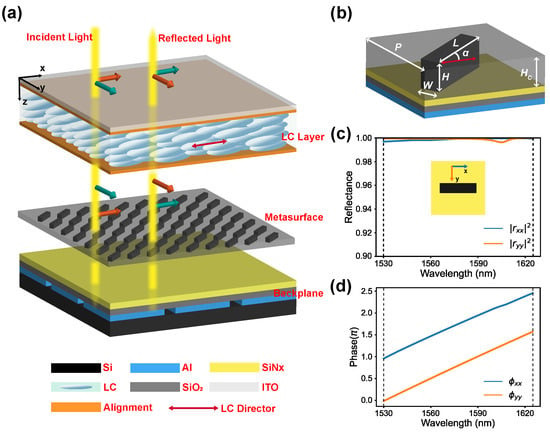
Figure 1
Open AccessArticle
Subtraction Method for Subpixel Stitching: Synthetic Aperture Holographic Imaging
by
Zhangyue Wei, John J. Healy and Min Wan
Photonics 2025, 12(6), 551; https://doi.org/10.3390/photonics12060551 - 29 May 2025
Abstract
Image stitching is a crucial technique in various fields of imaging and photography, which allows for the creation of high-resolution images by combining multiple smaller images with overlapping regions. Here, we propose a simple and fast method, the Subtraction Method (SM), for pixel
[...] Read more.
Image stitching is a crucial technique in various fields of imaging and photography, which allows for the creation of high-resolution images by combining multiple smaller images with overlapping regions. Here, we propose a simple and fast method, the Subtraction Method (SM), for pixel and subpixel image stitching using holographic data. The feasibility of the SM is verified at the pixel and subpixel level using two 2D images captured by a 4-f imaging system. Additionally, the application of the SM for holographic data is also explored. The effective aperture of an inline holographic imaging system is enlarged by stitching four in-line holograms, demonstrating enhanced resolution and image quality after reconstruction. The stitching accuracy and computational time of the SM is compared with the correlation method. With optimization, the result shows that the SM achieves high accuracy and requires less computational time for image stitching when compared to contemporary image stitching algorithms.
Full article
(This article belongs to the Special Issue Advances in Holography and Its Applications)
►▼
Show Figures
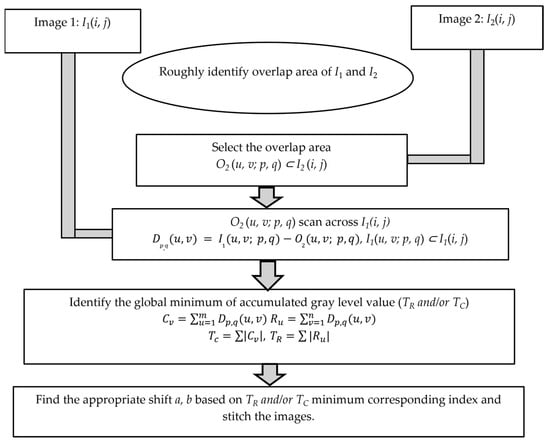
Figure 1
Open AccessArticle
Analysis and Suppression of Pump Beam Alignment Error in SERF Co-Magnetometer
by
Qi Yuan, Wenfeng Fan, Haoying Pang, Xue Han, Zhuo Wang and Wei Quan
Photonics 2025, 12(6), 550; https://doi.org/10.3390/photonics12060550 - 29 May 2025
Abstract
The beam angle error of the pump light in a K-Rb-21Ne spin-exchange relaxation-free atomic co-magnetometer (SERFCM) significantly degrades the efficiency of optical pumping and the system’s ability to suppress magnetic field noise. In this work, a system response model that incorporates
[...] Read more.
The beam angle error of the pump light in a K-Rb-21Ne spin-exchange relaxation-free atomic co-magnetometer (SERFCM) significantly degrades the efficiency of optical pumping and the system’s ability to suppress magnetic field noise. In this work, a system response model that incorporates the pump beam alignment error (PBAE) is established. The influence of PBAE on the scale factor, bandwidth, and magnetic noise response of the inertial output is analyzed. Theoretical results show that PBAE increases the internal magnetic field gradient, reduces the efficiency of nuclear spin hyperpolarization, and increases the nuclear spin relaxation rate, ultimately degrading the system’s scale factor, bandwidth, and magnetic noise suppression capability. Experimental results demonstrate that, compared to the original SERFCM with PBAE, aligning the pump laser using the proposed method improves the polarization strength of nuclear spins by approximately 10% and enhances magnetic noise suppression by 40%.
Full article
(This article belongs to the Special Issue Quantum Enhanced Devices and Instruments for Sensing Applications)
►▼
Show Figures
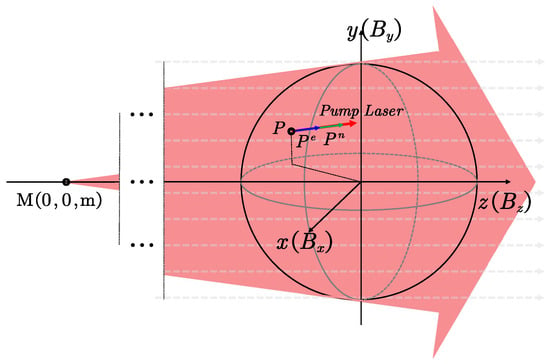
Figure 1
Open AccessCommunication
Polarization-Insensitive Silicon Photonic Variable Optical Attenuator
by
Meixin Li, Yuxuan Zhang, Hao Jiang, Haoran Wang, Danni Luo, Jing Yang, Yabin Li and Zanyun Zhang
Photonics 2025, 12(6), 549; https://doi.org/10.3390/photonics12060549 - 29 May 2025
Abstract
We propose and demonstrate a polarization-insensitive silicon photonic variable optical attenuator. The designed device uses a two-dimensional apodized grating coupler as a surface-normal coupling interface, which has the advantages of low-cost fiber packaging and polarization insensitivity. For optical attenuation, PIN diodes are inserted
[...] Read more.
We propose and demonstrate a polarization-insensitive silicon photonic variable optical attenuator. The designed device uses a two-dimensional apodized grating coupler as a surface-normal coupling interface, which has the advantages of low-cost fiber packaging and polarization insensitivity. For optical attenuation, PIN diodes are inserted into each waveguide to act as optical absorbers. The compact device, featuring a footprint of 250 × 850 μm2, exhibits a fiber-to-fiber insertion loss of 6 dB. Under a 3 V bias voltage, wavelength-dependent attenuation of 18 dB at 1295 nm and 26 dB at 1315 nm is achieved. Systematic characterization across diverse input polarization states confirms polarization-dependent loss below 0.5 dB under arbitrary polarization states, validating the device’s robust polarization insensitivity for wavelength-division multiplexing systems.
Full article
(This article belongs to the Special Issue Silicon Photonics: From Fundamentals to Future Directions)
►▼
Show Figures
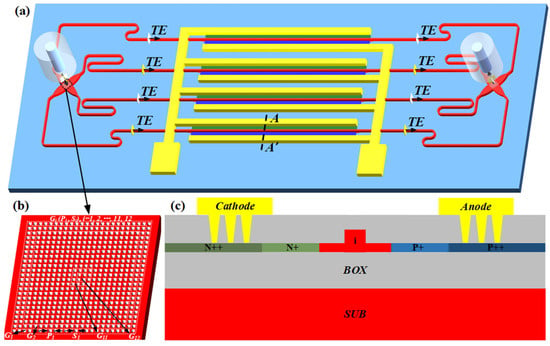
Figure 1
Open AccessArticle
Experimental Guide for Compact Bow-Tie Femtosecond Solid-State Laser Development
by
Vinícius Pereira Pinto, Giovana Trevisan Nogueira, Fátima Maria Mitsue Yasuoka and Jarbas Caiado de Castro Neto
Photonics 2025, 12(6), 548; https://doi.org/10.3390/photonics12060548 - 29 May 2025
Abstract
Bow-tie cavity configurations have gained significant attention due to their efficacy in facilitating stable resonator operation for applications requiring short pulse operation and high repetition rate pulses, offering versatility and reliability. While there is an extensive body of literature addressing the theoretical aspects
[...] Read more.
Bow-tie cavity configurations have gained significant attention due to their efficacy in facilitating stable resonator operation for applications requiring short pulse operation and high repetition rate pulses, offering versatility and reliability. While there is an extensive body of literature addressing the theoretical aspects and applications of this laser configuration, there exists a gap in practical insights and systematic approaches guidance pertaining to the development and precision alignment of this laser type. The paper achieves this by compiling a range of analytical and optimization techniques for the bow-tie cavity configuration and delineating the necessary steps for the optimization required for continuous wave operation. This ultimately leads to the attainment of the pulsed regime through the Kerr Lens Mode-locking technique, offering a detailed account of the development, optimization, and performance evaluation of a Ti:Sapphire femtosecond laser cavity, using dispersion-compensating mirrors to produce a low-energy pulse of 1 nJ, a high repetition rate of 1 GHz, and a short pulse duration of 61 fs. This work can be useful for researchers and engineers seeking to embark on the development of compact and high-performance femtosecond lasers for a spectrum of applications, encompassing biomedical imaging, laser-assisted surgery, spectroscopy, and optical frequency combs.
Full article
(This article belongs to the Section Lasers, Light Sources and Sensors)
►▼
Show Figures

Figure 1
Open AccessArticle
Air-Hole-Assisted Photonic Lanterns
by
Lijie Hou, Zhiqun Yang, Yaping Liu, Huihui Wang, Bingyi Zhao, Zhanhua Huang and Lin Zhang
Photonics 2025, 12(6), 547; https://doi.org/10.3390/photonics12060547 - 29 May 2025
Abstract
Exploring innovative approaches to enhance the performance of photonic lanterns is greatly valuable. In this paper, we first propose an air-hole-assisted pure silica-based capillary (AHC), featuring a single ring of embedded air holes. As a result, the PL based on the AHC exhibits
[...] Read more.
Exploring innovative approaches to enhance the performance of photonic lanterns is greatly valuable. In this paper, we first propose an air-hole-assisted pure silica-based capillary (AHC), featuring a single ring of embedded air holes. As a result, the PL based on the AHC exhibits good performance, successfully exciting LP01, LP11a & LP11b, LP21a & LP21b, LP02, and LP31a & LP21b modes. The average mode loss, mode-dependent loss, and maximum crosstalk are 0.08 dB, 0.04 dB, and −27.2 dB, respectively. In fact, the overall performance of the proposed AHC-based PL is on par with that of the traditional PL. Furthermore, an error analysis is provided to confirm the feasibility of our approach. The AHC-based PLs possess high numerical apertures and are expected to enable high spatial resolution imaging in optical imaging.
Full article
(This article belongs to the Special Issue Exploring Optical Fiber Communications: Technology and Applications)
►▼
Show Figures

Figure 1
Open AccessReview
Advances in Distal-Scanning Two-Photon Endomicroscopy for Biomedical Imaging
by
Conghao Wang, Biao Yan, Siyuan Ma, Haijun Li, Tianxuan Feng, Xiulei Zhang, Dawei Li, Lishuang Feng and Aimin Wang
Photonics 2025, 12(6), 546; https://doi.org/10.3390/photonics12060546 - 29 May 2025
Abstract
Two-photon endomicroscopy (2PEM), an endomicroscopic imaging technique based on the two-photon excitation effect, provides several technical benefits, including high spatiotemporal resolution, label-free structural and metabolic imaging, and optical sectioning. These characteristics make it extremely promising for biomedical imaging applications. This paper classifies distal-scanning
[...] Read more.
Two-photon endomicroscopy (2PEM), an endomicroscopic imaging technique based on the two-photon excitation effect, provides several technical benefits, including high spatiotemporal resolution, label-free structural and metabolic imaging, and optical sectioning. These characteristics make it extremely promising for biomedical imaging applications. This paper classifies distal-scanning 2PEMs based on their actuation mechanism (PZT or MEMS) and excitation–collection optical path configuration (common or separate path). Recent representative advancements are reviewed. Furthermore, we introduce its biomedical applications in tissue, organ, and brain imaging with free-behaving mice. Finally, future development directions for distal-scanning 2PEM are discussed.
Full article
(This article belongs to the Special Issue Emerging Trends in Multi-photon Microscopy)
►▼
Show Figures
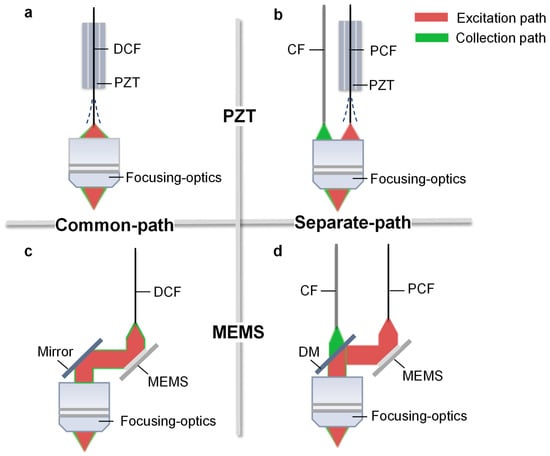
Figure 1
Open AccessCommunication
Temperature-Insensitive Cryogenic Packaging for Thin-Film Lithium Niobate Photonic Chips
by
Yongteng Wang, Yuxin Ma, Xiaojie Wang, Ziwei Zhao, Yongmin Li and Tianshu Yang
Photonics 2025, 12(6), 545; https://doi.org/10.3390/photonics12060545 - 28 May 2025
Abstract
As photonic integrated circuits (PICs) gain prominence in quantum communication and quantum computation, the development of efficient and stable cryogenic packaging technologies becomes paramount. This paper presents a robust and scalable cryogenic packaging method for thin-film lithium niobate (TFLN) photonic chips. The packaged
[...] Read more.
As photonic integrated circuits (PICs) gain prominence in quantum communication and quantum computation, the development of efficient and stable cryogenic packaging technologies becomes paramount. This paper presents a robust and scalable cryogenic packaging method for thin-film lithium niobate (TFLN) photonic chips. The packaged fiber-to-chip interface shows a coupling efficiency of 15.7% ± 0.3%, with minimal variation of ±0.5% as the temperature cools down from 295 K to 1.5 K. Furthermore, the packaged chip exhibits outstanding stability over multiple thermal cycling, highlighting its potential for practical applications in cryogenic environments.
Full article
(This article belongs to the Section Optoelectronics and Optical Materials)
►▼
Show Figures
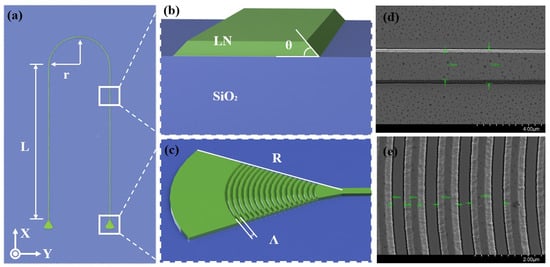
Figure 1
Open AccessArticle
High-Performance NIR Laser-Beam Shaping and Materials Processing at 350 W with a Spatial Light Modulator
by
Shuchen Zuo, Shuai Wang, Cameron Pulham, Yin Tang, Walter Perrie, Olivier J. Allegre, Yue Tang, Martin Sharp, Jim Leach, David J. Whitehead, Matthew Bilton, Wajira Mirihanage, Paul Mativenga, Stuart P. Edwardson and Geoff Dearden
Photonics 2025, 12(6), 544; https://doi.org/10.3390/photonics12060544 - 28 May 2025
Abstract
Shaping or splitting of a Gaussian beam is often desired to optimise laser–material interactions, improving throughput and quality. This can be achieved holographically using liquid crystal-on-silicon spatial light modulators (LC-SLMs). Until recently, maximum exposure has been limited to circa 120 W average power
[...] Read more.
Shaping or splitting of a Gaussian beam is often desired to optimise laser–material interactions, improving throughput and quality. This can be achieved holographically using liquid crystal-on-silicon spatial light modulators (LC-SLMs). Until recently, maximum exposure has been limited to circa 120 W average power with a Gaussian profile, restricting potential applications due to the non-linear (NL) phase response of the liquid crystal above this threshold. In this study, we present experimental tests of a new SLM device, demonstrating high first-order diffraction efficiency of η = 0.98 ± 0.01 at 300 W average power and a phase range Δφ > 2π at P = 383 W, an exceptional performance. The numerically calculated device temperature response with power closely matches that measured, supporting the higher power-handling capability. Surface modification of mild steel and molybdenum up to P = 350 W exposure is demonstrated when employing a single-mode (SM) fibre laser source. Exposure on mild steel with a vortex beam (m = +6) displays numerous ringed regions with varying micro-structures and clear elemental separation created by the radial heat flow. On molybdenum, with multi-spot Gaussian exposure, both MoO3 films and recrystallisation rings were observed, exposure-dependent. The step change in device capability will accelerate new applications for this LC-SLM in both subtractive and additive manufacturing.
Full article
(This article belongs to the Special Issue Fundamentals and Applications of Vortex Beams)
►▼
Show Figures

Figure 1
Open AccessCommunication
0.74 W Broadband Degenerate Femtosecond MgO-Doped Periodically Poled Lithium Niobate (MgO: PPLN) Optical Parametric Oscillator at 2056 nm
by
Yuxiang Zhao, Bobo Wang, Jinfang Yang, Taotao He, Hao Xu, Xue Qiu, Zhong Dong and Weijun Ling
Photonics 2025, 12(6), 543; https://doi.org/10.3390/photonics12060543 - 27 May 2025
Abstract
The degenerate optical parametric oscillator (OPO) is demonstrated to generate high-power, broadband mid-infrared MgO-doped periodically poled lithium niobate (MgO:PPLN) femtosecond laser at 151 MHz, synchronously pumped by a commercial Kerr-lens mode-locked Yb:KGW oscillator at 1028 nm. The average power of the degenerate OPO
[...] Read more.
The degenerate optical parametric oscillator (OPO) is demonstrated to generate high-power, broadband mid-infrared MgO-doped periodically poled lithium niobate (MgO:PPLN) femtosecond laser at 151 MHz, synchronously pumped by a commercial Kerr-lens mode-locked Yb:KGW oscillator at 1028 nm. The average power of the degenerate OPO centered at 2056 nm is as high as 740 mW, which is the highest output power from a reported 2 μm degenerate femtosecond OPO, pumped by a bulk solid-state laser. The full width at half maximum (FWHM) spectral bandwidth of the degenerate OPO is 87.4 nm, corresponding to a theoretical, Fourier-limited pulse duration of 51 fs. These remarkable results indicate that degenerate OPO is a great potential candidate technology for generating high-power and few-cycle femtosecond pulses around 2 μm. Such mid-infrared sources are well-suited for high harmonic generation, a pumping source for mid- to far-infrared OPO.
Full article
(This article belongs to the Special Issue Advances in Ultrafast Laser Science and Applications)
►▼
Show Figures
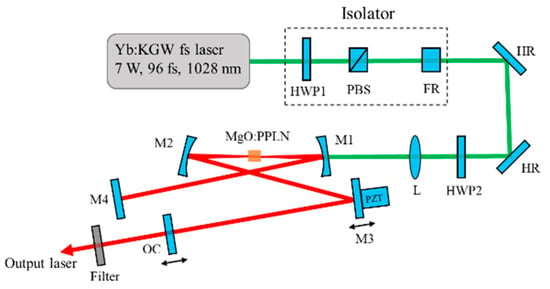
Figure 1
Open AccessCommunication
Single-Photon Computational Imaging System Based on Multi-Pixel Photon Counter
by
Rui Sun, Jiaye Kuang, Yi Ding, Jingjing Cheng, Jibin Zhang, Yadong Wang, Ryszard Buczynski and Wenzhong Liu
Photonics 2025, 12(6), 542; https://doi.org/10.3390/photonics12060542 - 27 May 2025
Abstract
Existing single-photon computational imaging systems always combine single-photon avalanche diode (SPAD)/photomultiplier tube (PMT) and time-correlated single-photon counting (TCSPC) together to collect the signals for imaging. However, the high equipment complexity and cost limit the wide applications of single-photon computational imaging systems. To overcome
[...] Read more.
Existing single-photon computational imaging systems always combine single-photon avalanche diode (SPAD)/photomultiplier tube (PMT) and time-correlated single-photon counting (TCSPC) together to collect the signals for imaging. However, the high equipment complexity and cost limit the wide applications of single-photon computational imaging systems. To overcome this problem, in this paper we propose to employ multi-pixel photon counter (MPPC) as the signal receiver to simplify the system. Due to the linearity of the output amplitude of MPPC, the number of received photons can be directly quantized; thus, the TCSPC is not necessary in our proposed imaging system. Experimental results show that the proposed system could obtain the 256 × 256 pixels images through 2000 measurements; the photons per pixel could be reduced to about 0.1.
Full article
(This article belongs to the Special Issue Optical Technology for Challenging Conditions:Methods and Applications)
►▼
Show Figures
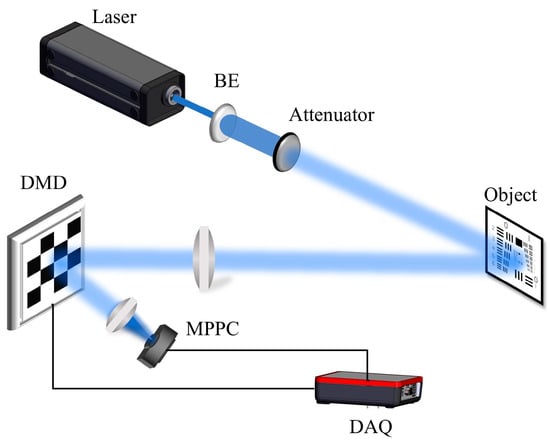
Figure 1
Open AccessArticle
On the Performance of Non-Lambertian Relay-Assisted 6G Visible Light Communication Applications
by
Jupeng Ding, Chih-Lin I, Jintao Wang and Hui Yang
Photonics 2025, 12(6), 541; https://doi.org/10.3390/photonics12060541 - 26 May 2025
Abstract
Visible light communication (VLC) has become one important candidate technology for beyond 5G and even 6G wireless networks, mainly thanks to its abundant unregulated light spectrum resource and the ubiquitous deployment of light-emitting diodes (LED)-based illumination infrastructures. Due to the high directivity of
[...] Read more.
Visible light communication (VLC) has become one important candidate technology for beyond 5G and even 6G wireless networks, mainly thanks to its abundant unregulated light spectrum resource and the ubiquitous deployment of light-emitting diodes (LED)-based illumination infrastructures. Due to the high directivity of VLC channel propagation, relay-based cooperative techniques have been introduced and explored to enhance the transmission performance of VLC links. Nevertheless, almost all current works are limited to scenarios adopting well-known Lambertian transmitter and relay, which fail to characterize the scenarios with distinctive non-Lambertian transmitter or relay. For filling this gap, in this article, relay-assisted VLC employing diverse non-Lambertian optical beam configurations is proposed. Unlike the conventional Lambertian transmitter and relay-based research paradigm, the presented scheme employs the commercially available non-Lambertian transmitter and relay to configure the cooperative VLC links. Numerical results illustrate that up to 40.63 dB SNR could be provided by the proposed non-Lambertian relay-assisted VLC scheme, compared with about a 34.22 dB signal-to-noise ratio (SNR) of the benchmark Lambertian configuration.
Full article
(This article belongs to the Special Issue Editorial Board Members’ Collection Series: Optical Wireless Communication)
►▼
Show Figures
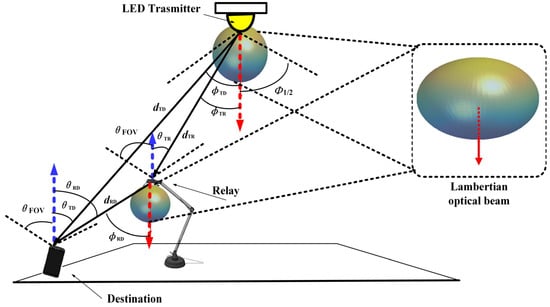
Figure 1
Open AccessArticle
Ultra-Low Loss Hybrid Anti-Resonant Hollow-Core Fiber with Double Semi-Circular Tubes Sandwiched Elliptic Tube
by
Zhipei Li, Shuaihang Wang, Ran Gao, Li Li, Lei Zhu, Qi Zhang and Xiangjun Xin
Photonics 2025, 12(6), 540; https://doi.org/10.3390/photonics12060540 - 26 May 2025
Abstract
We propose a new hollow-core fiber design based on a hybrid structure of nested elliptical and semicircular tubes. We numerically investigate the loss and single-mode performance of this design in the communication band and derive the values of each parameter of the fiber
[...] Read more.
We propose a new hollow-core fiber design based on a hybrid structure of nested elliptical and semicircular tubes. We numerically investigate the loss and single-mode performance of this design in the communication band and derive the values of each parameter of the fiber cladding structure that theoretically lead to the best performance of the fiber. The resulting structure has a minimum confinement loss as low as 0.00033 dB/km at 1550 nm and an astonishing extinction ratio of 2,439,607 for the higher-order modes, showing excellent loss and single-mode performance. In addition, the design also exhibits excellent bending insensitivity, with the loss gradually dropping well below 0.01 dB/km when the bending radius exceeds 14 cm. The proposed fiber structure has a very promising application in optical communication systems.
Full article
(This article belongs to the Special Issue Advanced Optical Transmission Techniques)
►▼
Show Figures

Figure 1
Open AccessArticle
Photonic-Aid Flexible Frequency-Hopping Signal Generator Based on Optical Comb Filtering
by
Yixiao Zhou, Xuan Li, Shanghong Zhao, Guodong Wang, Ruiqiong Wang, Jialin Ma and Zihang Zhu
Photonics 2025, 12(6), 539; https://doi.org/10.3390/photonics12060539 - 26 May 2025
Abstract
A novel photonics-assisted technique for generating reconfigurable frequency hopping (FH) signals is proposed and demonstrated through optical comb filtering (OCF). The arithmetic progression of frequency difference between OCF passbands and optical frequency comb lines is exploited to enable wavelength selection controlled by an
[...] Read more.
A novel photonics-assisted technique for generating reconfigurable frequency hopping (FH) signals is proposed and demonstrated through optical comb filtering (OCF). The arithmetic progression of frequency difference between OCF passbands and optical frequency comb lines is exploited to enable wavelength selection controlled by an intermediate frequency signal, with ultra-wideband FH signals subsequently being generated through optical heterodyning. Comprehensive theoretical and numerical investigations are conducted, demonstrating the successful generation of diverse FH waveforms including 5-, 10-, and 25-level stepped frequency signals, Costas-coded patterns, as well as complex wideband signals such as 30 GHz linear frequency modulated and 24 GHz sinusoidal chirped waveforms. Critical system considerations including laser frequency stability, FH speed, and parameter optimization are examined. Wide tunable bandwidth exceeding 30 GHz, good stability, and inherent compatibility with photonic integration is achieved, showing significant potential for advanced applications in cognitive radio and modern radar systems where high-performance frequency-agile signal generation is required.
Full article
(This article belongs to the Section Optoelectronics and Optical Materials)
►▼
Show Figures

Figure 1
Open AccessArticle
Gamma Irradiation-Induced Discoloration and Annealing Characteristics of K9 Glass
by
Fang Wang, Xianfu Meng, Yuhai Li, Hongjie Liu, Ye Tian and Shouhuan Zhou
Photonics 2025, 12(6), 538; https://doi.org/10.3390/photonics12060538 - 26 May 2025
Abstract
K9 glass is prone to developing color center defects under gamma irradiation, which exhibit strong absorption at specific laser wavelengths. However, most of these color centers exhibit an annealing phenomenon in natural environmental conditions, wherein their absorptive characteristics gradually diminish or even disappear.
[...] Read more.
K9 glass is prone to developing color center defects under gamma irradiation, which exhibit strong absorption at specific laser wavelengths. However, most of these color centers exhibit an annealing phenomenon in natural environmental conditions, wherein their absorptive characteristics gradually diminish or even disappear. Hence, this study proposes employing a high-temperature accelerated annealing approach to address the color centers induced in K9 glass by gamma irradiation, aiming to attain stable absorption characteristics for specific wavelengths. Initially, experiments were conducted to generate color centers in K9 glass using gamma irradiation to investigate the influence of different irradiation doses on the optical absorption characteristics of K9 glass. Subsequently, the gamma-irradiated K9 glass was subjected to natural annealing at room temperature, wherein the unstable color centers exhibited a slow recovery process during annealing. Building upon this, high-temperature annealing was employed to expedite the recovery of unstable color centers in darkened K9 glass. Finally, a comprehensive analysis of the mechanisms behind gamma irradiation and high-temperature annealing in K9 glass was conducted using various material characterization techniques. The research findings hold significant importance for efficiently obtaining K9 glass with stable absorption at specific wavelengths, thereby further enhancing the optical performance of K9 glass in extreme environments.
Full article
(This article belongs to the Topic Laser-Induced Damage Properties of Optical Materials)
►▼
Show Figures

Figure 1
Open AccessArticle
Precise Temperature Measurement Through Wavelength Modulation Heterodyne Phase-Sensitive Dispersion Spectroscopy
by
Guoquan Wang, Rende Wang and Weiqian Zhao
Photonics 2025, 12(6), 537; https://doi.org/10.3390/photonics12060537 - 26 May 2025
Abstract
This work proposes a precise temperature measurement method based on wavelength modulation heterodyne phase-sensitive dispersion spectroscopy (WM-HPSDS). Before the light intensity of the laser was modulated by an electro-optic modulator to generate a three-tone beam, the laser produced additional wavelength modulation by superimposing
[...] Read more.
This work proposes a precise temperature measurement method based on wavelength modulation heterodyne phase-sensitive dispersion spectroscopy (WM-HPSDS). Before the light intensity of the laser was modulated by an electro-optic modulator to generate a three-tone beam, the laser produced additional wavelength modulation by superimposing a high-frequency sinusoidal waveform on a slow sawtooth wave. The second harmonic peak value of the H2O dispersion phase at 7185.59 cm−1 and 7182.94 cm−1 was used to extract temperature through two-line thermometry. The experiment was carried out on a water-based thermostat and an acoustically excited Bunsen burner. The extracted temperatures of the thermostat agreed well with the reference temperature, and the deviation was within 1.5 °C. The measurement stability of the Bunsen burner flame was approximately 10.4 dB higher than that of direct HPSDS. Furthermore, measuring the peak values under varying laser powers demonstrated that WM-HPSDS was immune to optical power fluctuations. Therefore, this method has potential for measuring temperature in harsh environments.
Full article
(This article belongs to the Section Lasers, Light Sources and Sensors)
►▼
Show Figures
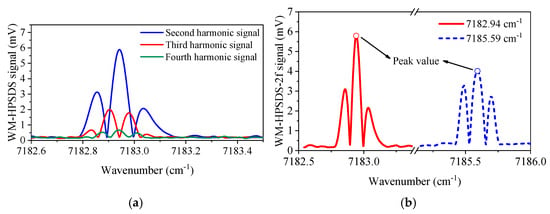
Figure 1
Open AccessReview
Review of Artifacts and Related Processing in Ophthalmic Optical Coherence Tomography Angiography (OCTA)
by
Zhefan Lin, Yitao Hu, Gongpu Lan, Jingjiang Xu, Jia Qin, Lin An and Yanping Huang
Photonics 2025, 12(6), 536; https://doi.org/10.3390/photonics12060536 - 25 May 2025
Abstract
►▼
Show Figures
Optical coherence tomography angiography (OCTA) is a non-invasive imaging modality that can provide rich three-dimensional microvascular information of fundus in ophthalmic imaging. However, various imaging artifacts may be generated during OCTA data acquisition and processing, originating from a number of factors such as
[...] Read more.
Optical coherence tomography angiography (OCTA) is a non-invasive imaging modality that can provide rich three-dimensional microvascular information of fundus in ophthalmic imaging. However, various imaging artifacts may be generated during OCTA data acquisition and processing, originating from a number of factors such as multiple light scattering, tissue motion, improper device operation and signal processing algorithms. Artifacts can detrimentally affect the qualitative interpretation of clinical pathologies and quantitative evaluation of vasculature parameters. This article firstly introduces the OCTA acquisition process and sources of artifacts, and then describes four different categories of artifacts in detail, mainly including light propagation and signal intensity-related artifacts, tissue motion artifacts, improper operation artifacts, and signal processing-related artifacts. Corresponding methods for the identification and processing of these artifacts are also presented. Furthermore, this article also details some recent progress in leveraging artificial intelligence (AI) technology in the identification and suppression of artifacts, showcasing its potential as a powerful tool in OCTA artifact processing. The development of artifact suppression techniques enables OCTA to reliably evaluate fundus diseases and monitor their progression. This development facilitates broader and deeper applications of OCTA in both research and clinics of ophthalmology.
Full article
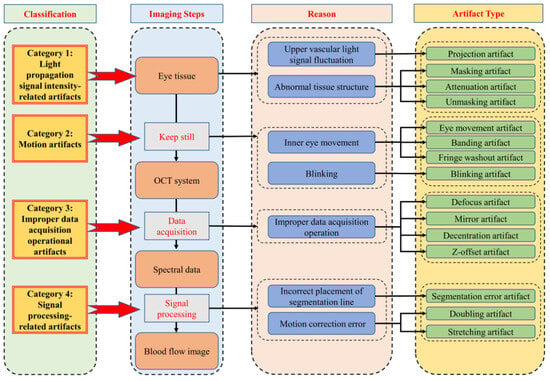
Figure 1
Open AccessArticle
Analysis of Photoelectric Detection Phase Polarity of Fiber-Optic Hydrophones Based on 3 × 3 Coupler Demodulation Technique
by
Yatao Li, Jianfei Wang, Mo Chen, Rui Liang, Yuren Chen, Zhou Meng, Xiaoyang Hu and Yang Lu
Photonics 2025, 12(6), 535; https://doi.org/10.3390/photonics12060535 - 25 May 2025
Abstract
Phase consistency among hydrophones in fiber-optic hydrophone (FOH) arrays is crucial for effective beamforming. In this study, we investigate the photoelectric detection phase characteristics of FOHs based on the 3 × 3 coupler demodulation technique. We develop a theoretical model combining the 3
[...] Read more.
Phase consistency among hydrophones in fiber-optic hydrophone (FOH) arrays is crucial for effective beamforming. In this study, we investigate the photoelectric detection phase characteristics of FOHs based on the 3 × 3 coupler demodulation technique. We develop a theoretical model combining the 3 × 3 coupler demodulation algorithm with coupled-mode theory to analyze acoustic signal responses. Our model reveals that phase shifts from coupler-to-photodetector and coupler-to-sensing-arm connections arise from different mechanisms, and both are capable of causing π rad phase inversions in demodulated signals. We demonstrate that distinct connection configurations can be classified into groups yielding identical polarity outcomes, and that the input port selection for incident light does not affect output signal phase polarity. Experimental results validate these theoretical predictions. This work establishes critical hardware-level prerequisites for phase polarity consistency in FOH arrays, complementing existing calibration techniques and enhancing array performance in underwater target detection and localization.
Full article
(This article belongs to the Section Lasers, Light Sources and Sensors)
►▼
Show Figures

Figure 1

Journal Menu
► ▼ Journal Menu-
- Photonics Home
- Aims & Scope
- Editorial Board
- Reviewer Board
- Topical Advisory Panel
- Instructions for Authors
- Special Issues
- Topics
- Sections
- Article Processing Charge
- Indexing & Archiving
- Editor’s Choice Articles
- Most Cited & Viewed
- Journal Statistics
- Journal History
- Journal Awards
- Conferences
- Editorial Office
Journal Browser
► ▼ Journal BrowserHighly Accessed Articles
Latest Books
E-Mail Alert
News
Topics
Topic in
Applied Sciences, Optics, Sensors, Materials, Fibers, Photonics, Micromachines
Distributed Optical Fiber Sensors
Topic Editors: Jian Li, Hao Wu, Giancarlo C. Righini, Zhe Ma, Yahui WangDeadline: 15 June 2025
Topic in
Applied Sciences, Electronics, JSAN, Photonics, Sensors, Telecom
Machine Learning in Communication Systems and Networks, 2nd Edition
Topic Editors: Yichuang Sun, Haeyoung Lee, Oluyomi SimpsonDeadline: 20 July 2025
Topic in
Energies, Photonics, Sustainability, Solar, Nanomaterials
Photovoltaic Materials and Devices—2nd Edition
Topic Editors: Bin Yang, Yongbo YuanDeadline: 31 December 2025
Topic in
Energies, Entropy, Photonics, Technologies, Optics, Solar
Advances in Solar Technologies, Second Edition
Topic Editors: Jayanta Deb Mondol, Annamaria Buonomano, Biplab DasDeadline: 31 March 2026

Conferences
Special Issues
Special Issue in
Photonics
Optical Technologies for Biomedical Science
Guest Editor: Geer TengDeadline: 30 May 2025
Special Issue in
Photonics
Terahertz Advancements in Fibers, Waveguides and Devices
Guest Editors: Yifei Zhang, Qi YangDeadline: 30 May 2025
Special Issue in
Photonics
Quantum Dot Light-Emitting Diodes: Innovations and Applications
Guest Editors: Chengzhao Luo, Chenghao BiDeadline: 30 May 2025
Special Issue in
Photonics
Advancements in Fiber Lasers and Their Applications
Guest Editors: Tianshu Wang, Chunyu Guo, Xiaohui LiDeadline: 30 May 2025










